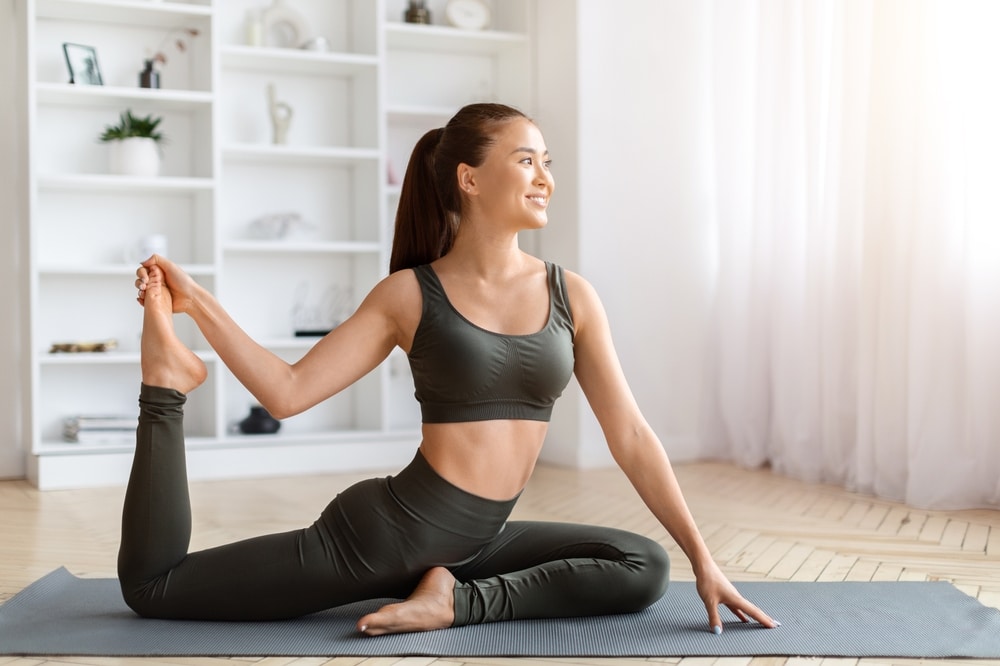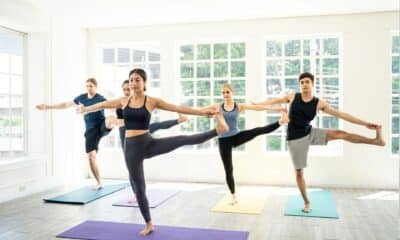Unlock The Magic Of Mermaid Pose In Your Yoga Practice
The Mermaid Pose, also known as Eka Pada Rajakapotasana in Sanskrit, is an enchanting and intricate asana that invites a mix of flexibility, balance, and strength. Not only does it act as an intense hip opener, but it also elongates your spine, chest, and shoulders, serving as a comprehensive pose for fostering flexibility and muscular fortitude.
However, it’s crucial to lay a solid foundation when performing mermaid pose, as per Heather Stants, a seasoned yoga and movement practitioner and the founder of Dance Flow Yoga. As with all advanced asanas, mermaid pose demands a strategic entry and ample preparation.
In this guide, we delineate the precise way to execute mermaid pose, its myriad benefits, suggestions for modifications or intensifications, and more.
Mastering mermaid pose every single time
Engaging in mermaid pose begins with a thorough warm-up and mindful execution, as recommended by Stants.
Prior emphasis on the elongation of the hip flexors and engaging in postures that promote back-bending, such as camel pose (Ustrasana), is advisable before committing to the full binding aspect of mermaid (where the hands are clasped together at the peak of the pose). It is vital to honor the body’s boundaries and listen to its signals, says Stants.
- Initiate with downward-facing dog (Adho Mukha Svanasana). Glide your right knee towards your right wrist, finding its place behind it while extending your left leg back, setting up for pigeon pose (Kapotasana). Aim to align your hips with the mat’s edge.
- Root into your fingertips as you elevate your torso, activating your core and elongating your spine, then gently descend into your hips. Assure yourself of your lower back’s comfort and the absence of hip tension at this stage. Utilize a block under the hip of the bent leg if necessary.
- Gradually flex your right (rear) knee, drawing your right heel closer to your gluteus.
- Extend your right arm backward, seizing the inside of your right foot or ankle. Keep the chest broad and the gaze directed forward.
- Nestle your right foot into the nook of your right elbow. If attainable, extend your left arm above your head and bring your hands together, forming a “mermaid tail” with your arms.
- Ensuring balance in the full version of the pose requires core engagement. Remember to breathe deeply—if breathing becomes constrained or rapid, it could indicate discomfort.
- Maintain the pose for five to 10 breaths, all the while keeping your chest open and hips aligned.
- When releasing the pose, let go of your foot and plant your hands on the mat to each side of your front leg. Propel yourself upward into a one-legged downward-facing dog, then revert to full downward-facing dog.
- Perform the same on the alternate side.
Unveiling the perks of mermaid pose
1. Extensive stretching for hips and shoulders
Mermaid pose renders an extensive stretch to the hip flexors, quadriceps, and shoulders, therefore augmenting flexibility. Stants points out that the pose is instrumental in lengthening hip flexors, which in turn facilitates other back-bending asanas and preps the body for more complex poses.
2. Bolstering core and back muscle groups
This stance demands robust engagement of the core muscles, thereby fostering stability and power within the core. A well-conditioned core leads to improved posture, a lower injury risk, and enhanced capacity for daily tasks like lifting sturdy objects.
3. Enhanced balancing ability
The retention of this posture calls for concentration and poise, which in the long run can heighten your coordination and equilibrium, aiding you in everyday activities like stooping to tie laces or negotiating stairs.
Adjusting mermaid pose for accessibility
1. Incorporating a strap
Can’t quite grasp your foot with your hands? Utilize a strap around the foot, securing it as you foster the necessary flexibility for binding. Stants frequently proposes this as a workaround for students with limited flexibility.
- Begins in downward-facing dog. Bring your right knee forward, placing it behind your right wrist as you retract your left leg back for pigeon pose. Level your hips to the mat’s front.
- Press into your fingertips as you lift your torso, engage the core, and extend your spine before settling into your hips. Gauge whether your lower back and hips feel strained. Use a block beneath the hip of the bent leg if needed.
- Loop a yoga strap around your right (back) foot, gently bringing your right heel towards your back gluteus muscle.
- With your right hand, reach back to grasp the inside of your right foot or ankle while keeping your chest broad and your focus straight ahead.
- Tuck your right foot into your right elbow’s crease. If you can, lift your left arm overhead and grasp the strap with both hands, emulating a “mermaid tail” with your arms.
- In the complete form of the pose, stabilize with engaged core muscles, ensuring continuous, measured breathing—if breaths become shallow or rapid, you may need to adjust your alignment or exit the pose.
- Remain in the stance for five to 10 breaths, keeping your chest open and hips square.
- To exit, release your grip, set your hands down on either side of your lead leg, press up into a one-legged downward-facing dog, followed by a full downward-facing dog.
- Attempt the pose on the reciprocal side.
2. Open your front leg angle
Modify the angle of your front shin, allowing it to rest at a wider, more natural position, thereby reducing the intensity exerted on the hips.
3. Forego the bind
You may also opt for a simpler version of the pose by simply holding your back foot with your hand, without wrapping it within the elbow for the bind.
Varieties of mermaid pose
1. Mermaid pose with a single-handed hold
Individuals just starting or those with less shoulder flexibility can maintain the back foot with their opposite hand, foregoing the elbow bind. According to Stants, this approach allows for a progressive shoulder opening and the same stretch benefit.
- Initiate in downward-facing dog. Move your right knee forwards to position it behind your right wrist while edging your left leg back for pigeon pose. Align your hips squarely to the mat’s edge.
- Using your fingertips for support, raise your torso, activate your core, and stretch your spine before descending back into the hips. Ensure there’s no strain on your lower back or hips, employing a block under the hip of the bent leg if necessary.
- Gently flex your right (rear) knee, luring your right heel closer to your gluteus muscle.
- Reach back with your right hand to seize the inside of your right foot or ankle. Keep your chest expansive and your eyes directed forward.
Once you’re
- While fully engaged in the pose, it demands considerable balance. Keep your core muscles active, but ensure that you’re also breathing normally—if your breath turns to quick or shallow inhales and exhales, it might indicate a level of discomfort.
- Continue to hold the pose for a duration of five to ten breaths, making certain to keep your chest open and hips even.
- To come out of the pose, gently let go of your foot and place your hands on the mat flanking your front leg. Lift into a one-legged downward-facing dog, then transition into the standard downward-facing dog position.
- Perform the same sequence on the alternate side.
2. Mermaid Pose with Hands Clasped Behind Head
This advanced flexibility version involves clasping both hands behind your head for a deeper stretch across the shoulders. This variation increases the expansion of the chest and places additional strain on your balance, perfectly suiting experienced yoga enthusiasts.
- Initiate from a downward-facing dog position. Move your right knee forward to rest it behind your right wrist and extend your left leg back to assume the pigeon pose. Orient your hips towards the mat’s front.
- With your fingertips on the mat, lift your upper body to engage your core and elongate the spine before settling into your pelvis. Double-check that your lower back and hips feel relaxed here, if not, consider the use of a block beneath the hip of the bent leg for support.
- Gently bend your right knee, bringing your heel closer to your right buttock.
- Use your right hand to reach out and secure the inner part of your right foot or ankle. Maintain an upright chest and direct your gaze ahead.
- Lift your left arm overhead to hold onto the inside of your right foot or ankle.
- In the pose’s fullest form, balancing is key. Remember to engage the core whilst keeping a steady breathing rhythm—if your breathing grows erratic or shallow, this could imply discomfort.
- Remain in the pose for five to ten breaths, keeping your chest open and hips parallel.
- To leave the pose, liberate your foot and place your hands on the floor on either side of the front leg. Push up into a one-legged downward-facing dog before returning to the standard downward-facing dog pose.
- Complete the sequence on the opposite side.
3. Mermaid Pose with a Forward Bend
A forward bend in the mermaid pose deepens the hip stretch and adds a new level to the balance challenge.
- Commence in a downward-facing dog pose. Advance your right knee behind your right wrist, extending the left leg back to form the pigeon pose. Align the hips to face the front of your mat.
- Using your fingertips for support, elevate your torso to activate your core and stretch out your spine before easing back into the hips. Prior to progressing further, ensure your lower back is comfortable and your hips at ease. If pressure is felt, a block placed under the hip of the bent leg can help.
- Slowly bend the right knee, drawing the heel towards the right buttock.
- Extend your right hand back to clasp the inside of the right foot or ankle, maintaining an expansive chest and forward-facing gaze.
- Bend your torso forward as much as possible.
- Attaining the full form of this pose requires notable balance. Keep your core firm and breaths consistent—if your breathing pattern alters to shallow, quick bursts, it might indicate a lack of comfort.
- Remain in the pose for a sequence of five to ten breaths, ensuring your chest remains broad and your hips squarely aligned.
- To exit, let go of the foot and plant your hands on each side of the forward leg. Push up into a one-legged downward-facing dog pose, then return to the complete downward-facing dog stance.
- Repeat the process on the other side.
4. Mermaid Pose with an Extended Binding Arm
Stretch the back leg straight while holding the foot, extending your arm for a thorough stretch across the chest and shoulders. This variation further opens the chest and enhances the shoulder stretch, perfect for adept yoga practitioners seeking an additional challenge.
- From a downward-facing dog, bring your right knee forward to just behind your right wrist, extending your left leg back to enter pigeon pose. Make sure your hips are squared to the mat’s front.
- Press down with your fingertips, lifting your upper body to engage your core and extend your spine before dropping into your hips. Check that your lower back is at ease and your hips are free from tension. If needed, a block under the hip of the bent leg could provide necessary support.
- Gently bend the right knee, guiding the heel toward the right buttock.
- Reach back with your right hand to grasp the inside of the right foot or ankle, keeping an elevated chest and a gaze directly ahead.
- Straighten your right leg back as far as is comfortable for you, preserving an open chest and hips squarely focused toward the front of the mat.
- When in the complete posture, balance becomes paramount. Keep the core engaged and continue breathing evenly—if you experience shallow or hurried breathing, it may signal discomfort in the pose.
- Hold the pose for five to ten breaths, with a wide chest and aligned hips.
- To exit the pose, release your foot and set your hands on the floor beside your front leg. Propel yourself up into a one-legged downward-facing dog, and afterwards into a full downward-facing dog.
- Perform again on the alternate side.
Common Mistakes in Mermaid Pose and Remedies
1. Misaligned Hips
Make sure your hips face squarely toward the front of the mat. If they tilt to one side, place a yoga block beneath your front leg’s hip to even them out. Stants reminds students of the allure of the bind but cautions against compromising proper alignment to achieve it prematurely.
2. Forced Bind
Take your time entering the bind. If you’re not yet supple enough in the shoulders or hips, concentrate on the preliminary steps and leverage props to facilitate improvement.
3. Hyperextension of the Lower Back
Activate your core to prevent sinking into the lower back. Focus on lengthening your spine, rather than just arching backward.
Suitable Candidates for Mermaid Pose and Those Who Should Refrain
Mermaid pose is suitable for:
- Advanced yoga students with a firm grounding in asanas that open the hips and bend the back.
- Individuals aiming to enhance flexibility in the hips, shoulders, and spine.
Steer clear of mermaid pose if:
-
- You have suffered injuries to the knees, hips, or lower back, as this asana applies pressure to those areas. Stants points out that “someone with a low back, hip, or knee injury might want to avoid practicing mermaid,” given the intensive stretching and binding involved.
- You are pregnant or have shoulder instability, as the binding element poses additional difficulty and potential risk.
















